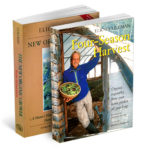Downloads
 Soil Blocking Worksheet
Soil Blocking WorksheetDownload the worksheet for this session. Space has been provided for those who would like to take notes. 🙂
Extra Resources
Equal Parts:
- Nitrogen Fertilizer: Feather meal or Soybean meal
- Greensand: Contains a broad-spectrum of micro-nutrients. An alternative is a dried seaweed product like kelp meal.
- Soft-rock Phosphate (Colloidal Phosphate): A clay material that provides phosphate needs to young plants
Full Recipe (makes 14 gallons of mix)
- Peat Moss: 6 gallons
- Compost: 6 gallons
- Course Perlite: 2 gallons
- Fertilizer Mix: 2 cups
Half Recipe (makes 7 gallons of mix)
- Peat Moss: 3 gallons
- Compost: 3 gallons
- Course Perlite: 1 gallon
- Fertilizer Mix: 1 cup
Quarter Recipe (makes 3.5 gallons of mix)
- Peat Moss: 1.5 gallons
- Compost: 1.5 gallons
- Course Perlite: 1/2 gallon
- Fertilizer Mix: 1/2 cup
Hand Held Soil Blockers
3/4" Mini Soil Blocker
1 1/2" Soil Blocker (recommended)
2" Soil Blocker (recommended)
4" Large Soil Blocker
Full Size Stand-Up Soil Blockers
Dibble Set
Dibbles are used for making different sized impressions on the top of each soil block or for making a larger square impression for either potting on smaller plants germinated in the mini blocks or for seeding large seeds.
Soil Block Propagation Trays
Propagation trays are useful for handling and transporting your soil blocks around.
Suggested Reading
 For a deeper look into this module read the following:
For a deeper look into this module read the following:
Four Season Harvest: p. 57-58; 98-101
The New Organic Grower: p. 127-157
8 Comments
Ray
December 11, 2015About your fertilizer. When you say “equal parts” is that like a gallon of each, or is it 10 pounds of each, or does it matter?
Paul
December 14, 2015Hi Ray – great question. When I say equal parts it doesn’t matter the amount, just that they are equal. So one cup of each or one gallon of each is fine. The main thing to note with the fertilizer mix is that once you have the “equal parts” mixed up – you will then measure out 2 cups of that for the soil block mix (using the full size recipe).
Michael
January 30, 2017Which size soil block do you recommend as a starter size? I see the benefit of the seed starter size (3/4) but which one 1 1/2, 2, 3 in order to keep startup costs lower. I am leaning 2, 3, but want your experience. Thanks.
Paul
February 2, 2017Hi Michael – great question. I’d suggest getting either the 1 1/2 or 2 inch size. And would probably recommend the 2 inch to you. The slightly larger size will allow your plants to grow longer in the block and keep you from being pressed to get them transplanted right away. The 3 inch size is a little large for many of the smaller crops and takes up a lot more room. The 2 inch blocker is quite ideal for most veggies as long as you can transplant them out withing 2-4 weeks of seeding.
Michael
February 7, 2017Thanks Paul. That was what I was thinking, but needed the extra verification!
Maria Coursey
April 3, 2017Hi Paul! A quick thank you for all the work you’re doing to help us become healthier and more self-sustaining! I am basically a new gardener and decided to follow your sample garden plan almost exactly. I have probably a million questions but will start with these…. I’m looking at the generic planting calendar and wondering which one blocker would be best for this planting schedule. Leaning toward the 2″, as you mentioned above. Can I use the 2″ for lettuce and kale? So how long can a seedling grow in the 2″ blocker before it needs to be transplanted? Does it depend on the seed? Thanks so much for all your help!
Paul
April 5, 2017Hi Maria, you are welcome! And I’d LOVE to hear how your garden goes this year.
Yes, I’d encourage you use the 2 inch blocker. Most seedlings will last around 2-3 weeks in the blocks before being ready to transplant. It does depend on the kind of seed you are growing though. Some grow faster than others – but overall, planning for 2-3 weeks should work best for you. And yes, you can definitely use it for lettuce and kale.
Cheers and keep up the good work!
Heather
July 1, 2019In the first video you talked about potting on from the mini soil blocks as soon as the seeds germinate. What about if I’m starting peppers and tomatoes in 2 inch soil blocks? When would be an idea time to pot them into 6” pots?